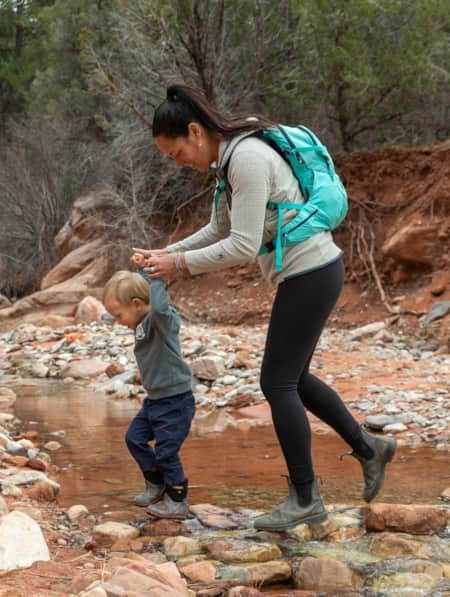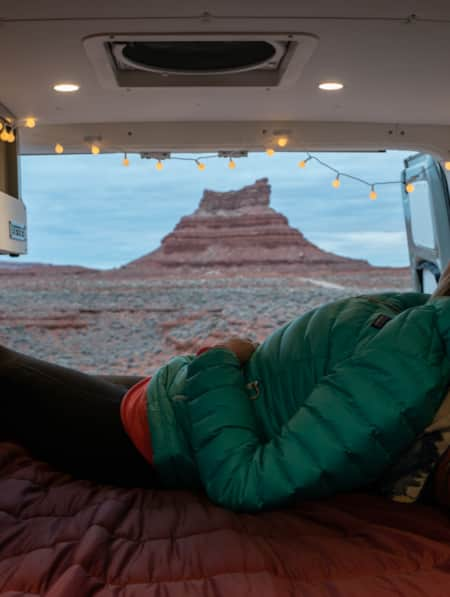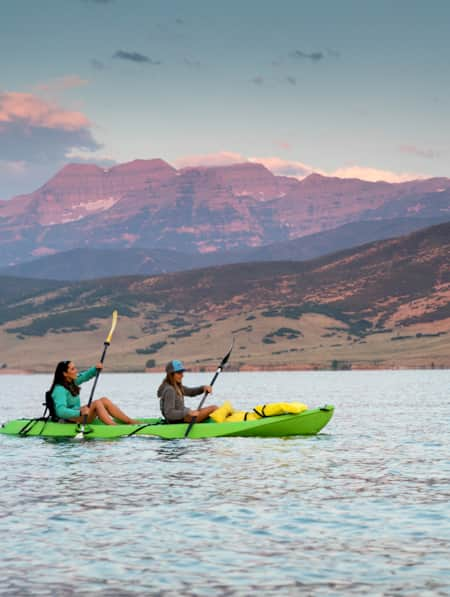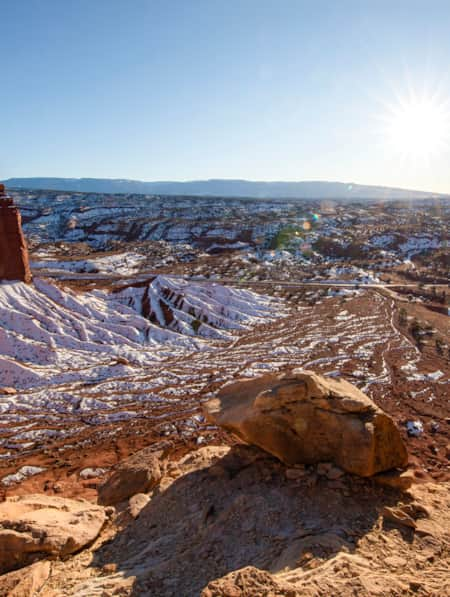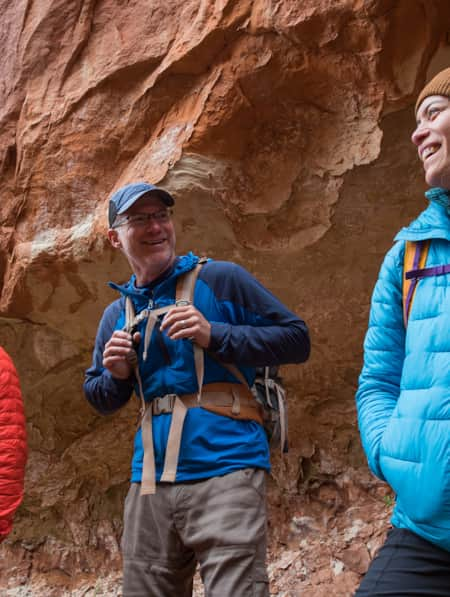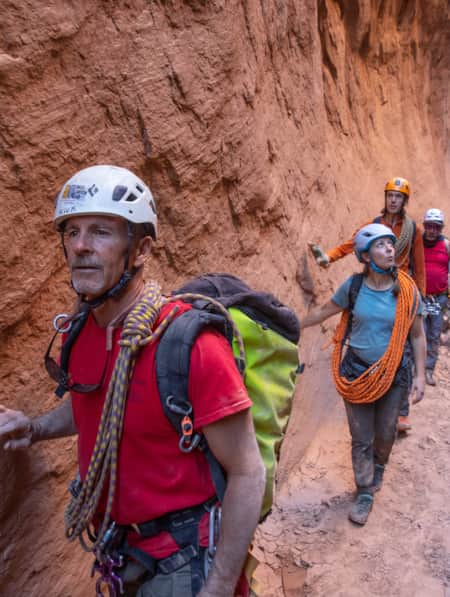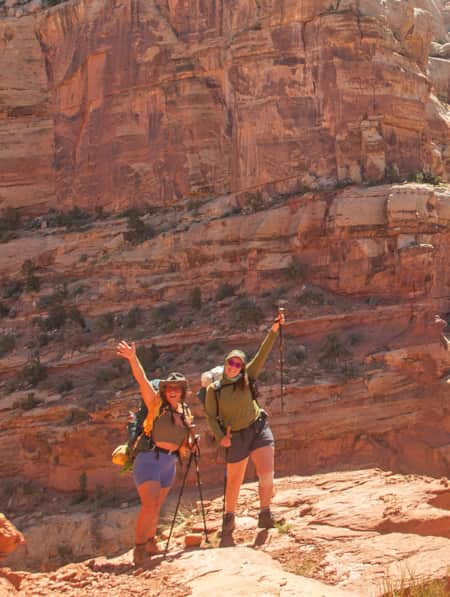Hiking the Desert in Capitol Reef National Park

- Before you come, get a general idea of the kind of hiking you will be doing. Call the appropriate management agency or a person familiar with the hike, or stop in at a visitor center and discuss your hiking plans with a ranger.
- Also get a report on road conditions leading to the trailhead.
- Avoid midsummer hikes. In most cases spring and fall hikes are preferable.
- Know what the water conditions are. If water quality is poor or if no water exists along the trail, you must carry all water in with you. Generally, one gallon per day per person is required.
- Do not drink untreated water.
- Some river water may be too silty to filter. Carrying in a collapsible plastic container permits the water to settle out while you are making camp.
- Prepare for the sun. Use a good sunscreen. A cap with a visor is also recommended. Legs can be particularly susceptible to reflected sun’s rays when hiking along rivers.
- Deerflies can be bothersome in some areas. A good brand of insect repellent helps to solve the problem.
- Watch the weather carefully. Flash flooding can be very dangerous. When hiking long distances in deep canyons and washes, be sure to get a reliable long-term forecast. Remember that it does not have to be raining where you are hiking for danger to exist. A storm miles up the canyon can mean trouble.
- Canyon hiking does not require the heavy boots necessary elsewhere. In fact, they become a burden when hiking long distances through water. Light canvas boots or old running shoes are recommended.
- When river crossings are required, line your pack with heavy-duty plastic bags. Seal the bags well, and the pack will float across. Some hikers bring along an inflatable air mattress to use for ferrying packs.
- Above all, prepare for your trip and use common sense.

Following Faint Trails
Trails that receive infrequent use often fade away in grassy meadows, on ridges, in dry washes, or through rocky sections. If a trail fades away before you, don’t panic. These sections are usually short, and you can often look ahead to see where the trail goes. If so, focus on the trail ahead and don’t worry about being off it for a short distance.
Also watch for other indicators that you are indeed on the right route, even if the trail isn’t clearly visible. These might include cairns, blazes, downfall cut with saws, paths cleared through thick timber, and trees with the branches whacked off on one side. Nowadays land managers discourage the use of blazes, and rangers use small metal reflective markers instead. However, you can still see old blazes along many trails. If you rely on blazes to follow a faint trail, make sure you follow only official blazes — which are shaped like an upside-down exclamation point — instead of blazes made by hunters, outfitters, or other hikers.
Archaeological Resources, the Law, and You
While hiking in almost any part of Utah, it is common to find archaeological sites and artifacts—dwellings, pottery, arrowheads, grinding stones, and woven sandals. These discoveries are an intriguing, exciting part of Utah hiking. They give us a glimpse of former cultures, of farming, architecture, recreation, food gathering, art, and religion many hundreds of years old.
Unfortunately, artifacts are becoming less common, dwellings are crumbling under the weight of hikers scrambling over them, and rock art is being crowded by the likes of JIM LOVES SUE.
Two federal laws, the Antiquities Act of 1906 and the Archaeological Resources Protection Act of 1979, forbid removal or destruction of archaeological resources on Utah’s federal lands.These acts are intended to protect and preserve the resources for the future — for the scientific community and for other hikers who follow after you. Stiff fines and imprisonment can result from failure to follow these guidelines. The Utah State Antiquities Act, enacted in 1973, provides similar protection on state lands.
Seemingly innocent actions can contribute to irreparable damage. Ancient painted pigments can be altered by the oil from fingerprints. Sitting or climbing on rock walls can turn culturally priceless ruins into rubble. Walking across middens, the ancient trash heaps below ruins, can damage sites.
What can you do to help protect our state’s splendid resources? First, recognize that you and several other hikers bringing home “just one small arrowhead” can over time be just as damaging as large-scale and purposeful vandalism. It takes a little longer, but the result is the same. So enjoy and study what you find, but leave all sites and artifacts undisturbed. Admire rock art from a distance and never touch it. When approaching a cultural site, avoid walking on soft soils to reduce the chance of erosion. Stay out of ruins. Report any vandalism to the nearest federal or state resource office. In some cases rewards are offered.
Read these additional resources to learn how to travel thoughtfully and experience Capitol Reef National Park most fully.

